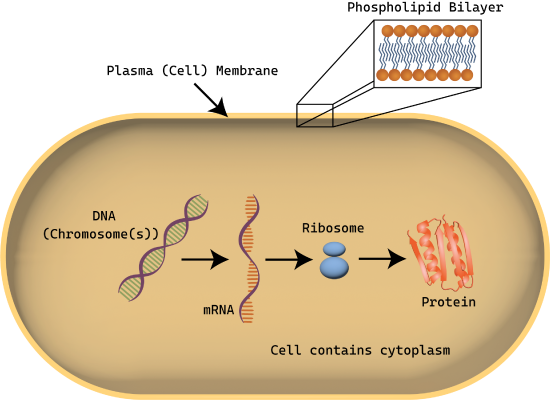2.2: Shared Characteristics of Cell Structure
- Page ID
- 123588
- Compare and contrast cellular (living) microbes, viruses, and prions based on their structures, genetic material, and mechanisms of replication.
- Explain the difference between the terms prokaryotic and eukaryotic.
- Compare and contrast "prokaryotic" (bacterial) cell structure with eukaryotic cell structure with respect to typical size, cell boundary, and presence/absence of various intracellular compartments.
Cell theory states that the cell is the fundamental unit of life. However, cells vary significantly in size, shape, structure, and function. At the simplest level of construction, all cells possess a few fundamental components. These include cytoplasm (a gel-like substance composed of water and dissolved chemicals needed for growth), which is contained within a plasma membrane (also called a cell membrane or cytoplasmic membrane); one or more chromosomes (DNA), which contain the genetic blueprints of the cell; mRNA, which carries the instructions for building proteins from the DNA to the ribosomes; and ribosomes, organelles used for the production of proteins.

Figure \(\PageIndex{1}\): Generalized structure of a cell. (2024;J.Kagle)
Beyond these basic components, cells can vary greatly between organisms, and even within the same multicellular organism. The two largest categories of cells—prokaryotic cells and eukaryotic cells—are defined by major differences in several cell structures. Prokaryotic cells lack a nucleus surrounded by a complex nuclear membrane and generally have a single, circular chromosome located in a nucleoid. Eukaryotic cells have a nucleus surrounded by a complex nuclear membrane that contains multiple, rod-shaped chromosomes.
All plant cells and animal cells are eukaryotic. Some microorganisms are composed of prokaryotic cells, whereas others are composed of eukaryotic cells. Prokaryotic microorganisms are classified within the domains Archaea and Bacteria, whereas eukaryotic organisms are classified within the domain Eukarya.
The structures inside a cell are analogous to the organs inside a human body, with unique structures suited to specific functions. Some of the structures found in prokaryotic cells are similar to those found in some eukaryotic cells; others are unique to prokaryotes. Although there are some exceptions, eukaryotic cells tend to be larger than prokaryotic cells. The comparatively larger size of eukaryotic cells dictates the need to compartmentalize various chemical processes within different areas of the cell, using complex membrane-bound organelles. In contrast, prokaryotic cells generally lack membrane-bound organelles; however, they often contain inclusions that compartmentalize their cytoplasm.
Most biologists do not consider viruses to be alive. Unlike the Eukaryotes, Archaea, and Bacteria, viruses are acellular, meaning they are not composed of cells. Although viruses have some kind of genetic material (DNA or RNA) and an external structure constructed of protein, they do not have ribosomes, do not make their own proteins, and don't have a plasma membrane (although some are surrounded by a lipid layer called an envelope).

